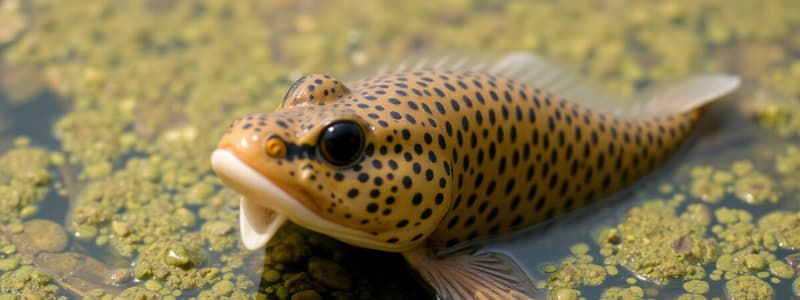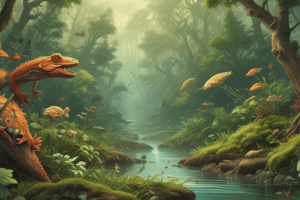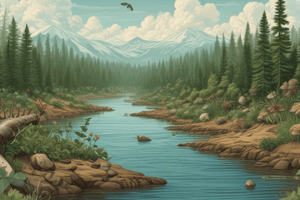Podcast
Questions and Answers
What is a primary method by which invasive species enter the Great Lakes?
What is a primary method by which invasive species enter the Great Lakes?
- Through the release of ballast water from ships (correct)
- By being transported in luggage
- Via aerial dispersal during storms
- By swimming from neighboring lakes
What is a significant impact of zebra mussels on the Great Lakes?
What is a significant impact of zebra mussels on the Great Lakes?
- They clog water pipes and steal food from native species (correct)
- They increase the population of native fish
- They provide food for birds
- They only affect swimming activities
What danger do Asian carp pose to water recreationists?
What danger do Asian carp pose to water recreationists?
- They have poisonous venom
- They deplete oxygen levels in the water
- They are aggressive towards other fish
- They jump out of the water and can injure people (correct)
Why were Asian carp originally brought to the United States?
Why were Asian carp originally brought to the United States?
What is one response taken to prevent invasive species from entering the Great Lakes?
What is one response taken to prevent invasive species from entering the Great Lakes?
Which invasive species is known to reproduce rapidly in the Great Lakes?
Which invasive species is known to reproduce rapidly in the Great Lakes?
How do zebra mussels affect recreational swimming?
How do zebra mussels affect recreational swimming?
Which river systems did Asian carp invade in the 1980s?
Which river systems did Asian carp invade in the 1980s?
What do scientists estimate about the number of invasive species in the Great Lakes?
What do scientists estimate about the number of invasive species in the Great Lakes?
What specific action has been taken by several states regarding Asian carp?
What specific action has been taken by several states regarding Asian carp?
What mythical figure is associated with the Great Lakes region, known for his enormous size and strength?
What mythical figure is associated with the Great Lakes region, known for his enormous size and strength?
Why was habitat loss not a significant concern during the time of Paul Bunyan stories?
Why was habitat loss not a significant concern during the time of Paul Bunyan stories?
What was one major activity that contributed to forest habitat loss in the Great Lakes region?
What was one major activity that contributed to forest habitat loss in the Great Lakes region?
What percentage of the original forest in the Great Lakes region is estimated to have been lost due to development?
What percentage of the original forest in the Great Lakes region is estimated to have been lost due to development?
What is the role of wetlands in the environment?
What is the role of wetlands in the environment?
How were wetlands traditionally viewed by many people in the past?
How were wetlands traditionally viewed by many people in the past?
What actions are being taken to protect wetlands in the Great Lakes region?
What actions are being taken to protect wetlands in the Great Lakes region?
What type of soil conditions do wetlands typically have?
What type of soil conditions do wetlands typically have?
What was the primary cause of wetland loss in the Great Lakes region?
What was the primary cause of wetland loss in the Great Lakes region?
What is the main goal of timber companies in the Great Lakes region today?
What is the main goal of timber companies in the Great Lakes region today?
What animal is Paul Bunyan's companion in the folktales?
What animal is Paul Bunyan's companion in the folktales?
What proportion of the original forest in the Great Lakes region has been lost to development?
What proportion of the original forest in the Great Lakes region has been lost to development?
What was the historical perception of wetlands in the Great Lakes region?
What was the historical perception of wetlands in the Great Lakes region?
What is a wetland?
What is a wetland?
What is one current effort being made to restore forest habitat in the Great Lakes region?
What is one current effort being made to restore forest habitat in the Great Lakes region?
What is one way wetland habitats are being protected today?
What is one way wetland habitats are being protected today?
What help do wetlands provide during storms?
What help do wetlands provide during storms?
What impact did development have on wetlands in the Great Lakes region?
What impact did development have on wetlands in the Great Lakes region?
What is the significance of creating more wetland when one is destroyed?
What is the significance of creating more wetland when one is destroyed?
What was a primary reason settlers cleared forests in the Great Lakes region?
What was a primary reason settlers cleared forests in the Great Lakes region?
What does habitat loss primarily affect in the Great Lakes region?
What does habitat loss primarily affect in the Great Lakes region?
Which body of water is said to have been scooped out by Paul Bunyan for his ox?
Which body of water is said to have been scooped out by Paul Bunyan for his ox?
What percentage of the original wetlands in the Great Lakes region have disappeared?
What percentage of the original wetlands in the Great Lakes region have disappeared?
What was one reason people originally believed wetlands were unimportant?
What was one reason people originally believed wetlands were unimportant?
Which practice is part of the current efforts to restore forests in the Great Lakes region?
Which practice is part of the current efforts to restore forests in the Great Lakes region?
How do wetlands contribute to flood control?
How do wetlands contribute to flood control?
What is a common characteristic of wetlands?
What is a common characteristic of wetlands?
What is one method used to create new wetlands when existing ones are destroyed?
What is one method used to create new wetlands when existing ones are destroyed?
What was a notable consequence of settlers moving into the Great Lakes region in the 1800s?
What was a notable consequence of settlers moving into the Great Lakes region in the 1800s?
What is a primary goal of public and private groups regarding wetlands today?
What is a primary goal of public and private groups regarding wetlands today?
What is the primary way timber companies are working to restore forest habitats?
What is the primary way timber companies are working to restore forest habitats?
Which of the following describes wetlands?
Which of the following describes wetlands?
What was a historical view on wetlands by many people?
What was a historical view on wetlands by many people?
What major shift is currently occurring regarding forest habitats in the Great Lakes region?
What major shift is currently occurring regarding forest habitats in the Great Lakes region?
What is one action being taken to protect wetland areas today?
What is one action being taken to protect wetland areas today?
Why did settlers clear forests in the Great Lakes region during the 1800s?
Why did settlers clear forests in the Great Lakes region during the 1800s?
What is the significance of creating more wetland for every acre destroyed?
What is the significance of creating more wetland for every acre destroyed?
Which term describes the natural environment in which a plant or animal lives?
Which term describes the natural environment in which a plant or animal lives?
What impact did development have on the original forests in the Great Lakes region?
What impact did development have on the original forests in the Great Lakes region?
Flashcards
Invasive species
Invasive species
Non-native plants or animals that move into a new ecosystem and disrupt it.
Great Lakes Invasive Species
Great Lakes Invasive Species
Plants and animals, not originally from the Great Lakes, who cause harm in the Great Lakes ecosystem.
Ballast water
Ballast water
Water pumped into a ship's hull to help it stay stable.
Zebra Mussels
Zebra Mussels
Signup and view all the flashcards
Asian carp
Asian carp
Signup and view all the flashcards
Ecosystem disruption
Ecosystem disruption
Signup and view all the flashcards
Preventing invasive species
Preventing invasive species
Signup and view all the flashcards
Mississippi River
Mississippi River
Signup and view all the flashcards
Control methods
Control methods
Signup and view all the flashcards
Reintroducing species
Reintroducing species
Signup and view all the flashcards
Habitat Loss
Habitat Loss
Signup and view all the flashcards
Great Lakes Forest Loss
Great Lakes Forest Loss
Signup and view all the flashcards
Restoring Forest Habitat
Restoring Forest Habitat
Signup and view all the flashcards
Wetlands
Wetlands
Signup and view all the flashcards
Wetland Habitat Loss
Wetland Habitat Loss
Signup and view all the flashcards
Wetland Protection Efforts
Wetland Protection Efforts
Signup and view all the flashcards
Paul Bunyan
Paul Bunyan
Signup and view all the flashcards
Great Lakes Stories
Great Lakes Stories
Signup and view all the flashcards
Timber Companies' Role
Timber Companies' Role
Signup and view all the flashcards
Impact of Development
Impact of Development
Signup and view all the flashcards
What are some key factors that have contributed to the loss of forests in the Great Lakes region?
What are some key factors that have contributed to the loss of forests in the Great Lakes region?
Signup and view all the flashcards
What is a habitat?
What is a habitat?
Signup and view all the flashcards
Why was habitat loss a concern in the Great Lakes region?
Why was habitat loss a concern in the Great Lakes region?
Signup and view all the flashcards
What's the impact of habitat loss?
What's the impact of habitat loss?
Signup and view all the flashcards
How are forests being restored in the Great Lakes?
How are forests being restored in the Great Lakes?
Signup and view all the flashcards
What are wetlands?
What are wetlands?
Signup and view all the flashcards
What is a wetland's role?
What is a wetland's role?
Signup and view all the flashcards
Why are wetlands important?
Why are wetlands important?
Signup and view all the flashcards
How are wetlands being protected?
How are wetlands being protected?
Signup and view all the flashcards
Why is it important to protect habitats?
Why is it important to protect habitats?
Signup and view all the flashcards
The impact of Development on the Great Lakes
The impact of Development on the Great Lakes
Signup and view all the flashcards
What was Paul Bunyan?
What was Paul Bunyan?
Signup and view all the flashcards
Forest Restoration
Forest Restoration
Signup and view all the flashcards
Study Notes
Invasive Species in the Great Lakes
- Over 185 invasive species currently present in the Great Lakes.
- Invasive species are non-native plants and animals that disrupt ecosystems.
Methods of Arrival
- Many invaders arrive via water, often in ships' ballast water.
- Ballast water is pumped into the ship's hull to maintain stability. The water is then released, potentially introducing non-native species to a new location.
- Some, like zebra mussels, attach to ships' hulls and are transported.
Impacts of Invasive Species
- Invasive species disrupt the food web.
- Zebra mussels rapidly reproduce and significantly impact native species, causing food depletion, water pipe clogging, damage to docks, and pose a danger due to their sharp shells
- Sea lampreys negatively impact the ecosystem.
- Alewives significantly affected by the ecosystem.
- Asian carp pose a risk to boaters and water-skiers, damaging vessels and causing injury.
- Asian carp present in the Mississippi, Missouri, and Ohio rivers since the 1980s.
- Potential concern is spread to the Great Lakes, forming carp-dominated ecosystems.
Mitigation Efforts
- Preventing more invaders:
- Improved ballast water treatment is being implemented.
- Barrier to stop Asian carp
- Controlling invasive species:
- Introduction of predators to target specific species (e.g., Pacific salmon to control alewives).
- Resurgence of native species, e.g., alligator gar, to control Asian carp populations
- Controlling the Spread:
- Banning the sale of live Asian carp to limit further introductions
Studying That Suits You
Use AI to generate personalized quizzes and flashcards to suit your learning preferences.




